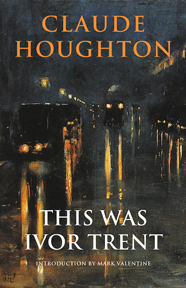|
BOOK DETAILS
Trade paper ISBN-13: 978-1943910175 List Price: $19.99 U.S. Pages: 260 Published: 2015 |
Chaos is Come Again (1932)
Claude Houghton Book Description
England, 1932. The nation had just begun to recover from the wounds of the First World War when economic catastrophe struck with the Great Depression. It is against this background that Vernon Dexter arrives at the old manor house at Greystones, home of the notorious philanderer Sir Keith Petersley and his eccentric wife Lady Isabelle, to tutor their disabled son Eric. As he meets each of the strange members of the Petersley clan and gets caught up in the exciting dramas that unfold at Greystones, we see that the Petersleys are more than just a family: they are representative of an entire way of English life that is on the verge of extinction, to be replaced by a new age of chaos and greed. Inexplicably neglected today, Claude Houghton (1889-1961) was one of the finest English novelists of the interwar period. Though he is best known for novels like I Am Jonathan Scrivener (1930), psychological thrillers infused with philosophy and mysticism, in Chaos Is Come Again (1932), his theme is more overtly political. In light of the economic crises of recent years, today’s readers will find Houghton’s novel eerily prescient and his predictions about a society dominated by capitalistic greed remarkably accurate. |
reviews
“A criticism of life today, full of ideas and dramatic moments; it is genuine in its psychology and thrilling in its action.” - The Times
“I read Chaos Is Come Again with intense interest. It has not a dull page in it.” - Compton Mackenzie
“Had Emily Brontë written Heartbreak House the result might have been rather like Mr. Claude Houghton's richly inventive Chaos Is Come Again.” - Norman Collins
“He is an extremely interesting novelist, and a genuinely original one.” - J.B. Priestley
“This is a novel of quite unusual interest. Mr. Houghton is an experimenter, possessed of talent and courage.” - L.A.G. Strong
“Mr. Houghton has an acute and ruthless mind ... It is a book full of nervous energy, and full of delightful ingenuities.” - Frank Swinnerton
“I read Chaos Is Come Again with intense interest. It has not a dull page in it.” - Compton Mackenzie
“Had Emily Brontë written Heartbreak House the result might have been rather like Mr. Claude Houghton's richly inventive Chaos Is Come Again.” - Norman Collins
“He is an extremely interesting novelist, and a genuinely original one.” - J.B. Priestley
“This is a novel of quite unusual interest. Mr. Houghton is an experimenter, possessed of talent and courage.” - L.A.G. Strong
“Mr. Houghton has an acute and ruthless mind ... It is a book full of nervous energy, and full of delightful ingenuities.” - Frank Swinnerton
ALSO AVAILABLE THROUGH ONLINE RETAILERS
MORE TITLES BY THIS AUTHOR
MORE TITLES BY THIS AUTHOR

Claude Houghton Oldfield was born in 1889 in Sevenoaks, Kent and was educated at Dulwich College. He trained as an accountant and worked in the Admiralty in the First World War, rejected for active service by poor eyesight. In 1920 he married a West End actress, Dulcie Benson, and they lived in a cottage in the Chiltern Hills. To a writers’ directory, Houghton gave his hobbies as reading in bed, riding, visiting Devon and abroad, and talking to people different to himself. He added: “I like dawn, and the dead of night, in great cities.” He disliked fuss, noise, crowds, rows, and being misquoted, or being told how much he owed “to some writer I’ve never read”.
Houghton’s earliest writing was poetry and drama before turning to prose fiction with his first novel, Neighbours, in 1926. In the 1930s, Houghton published several well-received novels that met with solid sales and respectable reviews, including I Am Jonathan Scrivener (1930), easily his most popular and best-known work, Chaos Is Come Again (1932), Julian Grant Loses His Way (1933), This Was Ivor Trent (1935), Strangers (1938), and Hudson Rejoins the Herd (1939). Although he published nearly a dozen more novels throughout the 1940s and 1950s, most critics feel his later works are less significant than his novels of the 1930s.
Houghton was a prolific correspondent, generous in devoting his time to answering letters and signing copies for readers who enjoyed his books. One of these was novelist Henry Miller, who never met Houghton but began an impassioned epistolary exchange with him after being profoundly moved by his works. Houghton’s other admirers included his contemporaries P. G. Wodehouse, Clemence Dane, and Hugh Walpole. Houghton died in 1961.
Houghton’s earliest writing was poetry and drama before turning to prose fiction with his first novel, Neighbours, in 1926. In the 1930s, Houghton published several well-received novels that met with solid sales and respectable reviews, including I Am Jonathan Scrivener (1930), easily his most popular and best-known work, Chaos Is Come Again (1932), Julian Grant Loses His Way (1933), This Was Ivor Trent (1935), Strangers (1938), and Hudson Rejoins the Herd (1939). Although he published nearly a dozen more novels throughout the 1940s and 1950s, most critics feel his later works are less significant than his novels of the 1930s.
Houghton was a prolific correspondent, generous in devoting his time to answering letters and signing copies for readers who enjoyed his books. One of these was novelist Henry Miller, who never met Houghton but began an impassioned epistolary exchange with him after being profoundly moved by his works. Houghton’s other admirers included his contemporaries P. G. Wodehouse, Clemence Dane, and Hugh Walpole. Houghton died in 1961.





